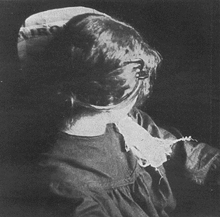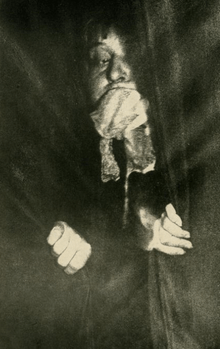Eva Carrière

Eva Carrière (born Marthe Béraud), also known as Eva C, was a prominent spiritualist and psychic medium in the early 20th century. She was born in 1886 in France.
Biography
Béraud was the daughter of a French officer and was the fiancée of General Elie Noël's son, Maurice, who died in the Congo from tropical disease in 1904 before the marriage could take place. Béraud was living with General Noël and his wife at Villa Carmen in Algiers and claimed her mediumship ability had developed after the death of her fiancé.[1]

In 1905 she held a series of séances at Villa Carmen and sitters were invited. In these séances she claimed to materialize a spirit called Bien Boa a 300-year-old Brahmin Hindu, however, photographs taken of Boa looked like the figure was made from a large cardboard cutout.[2] In other sittings Charles Richet reported that Boa was breathing, had moved around the room and had touched him, a photograph taken revealed Boa to be a man dressed up in a cloak, helmet and beard.[3]
A newspaper article in 1906 had revealed that an Arab coachman known as Areski who had previously worked at the villa had been hired to play the part of Bien Boa and that the entire thing was a hoax. Areski wrote that he made his appearance into the room by a trapdoor. Béraud had also admitted to being involved with the hoax.[4]
In 1909 Béraud changed her name to Eva Carrière (Eva C) and began a new career as a medium to hide the fraud of her past.[5]
Investigations
Carrière's psychic performances were investigated by Arthur Conan Doyle, author of the Sherlock Holmes mystery series.[6] He believed that her performances were genuine and that she was not engaged in any deception. Another psychic investigator of the time, Harry Houdini, observed one of her séances and asserted that they were fraudulent. Houdini was never convinced by Carrière and likened her performance to a magician's trick, the Hindu needle trick.[7]


The psychical researcher Gustav Geley investigated Carrière and wrote she was a genuine medium but never-published photographs were discovered after Geley's death which revealed fraudulent activity from the medium's companion, Juliette Bisson, such as wires seen running from Carrière's head supporting fake ectoplasm.[8] Another researcher Albert von Schrenck-Notzing also investigated Carrière and believed the ectoplasm she produced was genuine. The psychiatrist Mathilde Ludendorff wrote that the experiments of Schrenck-Notzing were unscientific and that he had been duped by tricks of Carrière.[9] In the Schrenck-Notzing mediumship sessions with Carrière the scientific controls were scarce and there was evidence that she had freed her hands in the séance room.[10]
Carrière has been described as "perverse and neurotic".[11] She was well known for running around the séance room naked indulging in sexual activities with her audience. Her companion Juliette Bisson (1861–1956) would, during the course of the séance sittings with Schrenck-Notzing, introduce her finger into Eva's vagina to ensure no "ectoplasm" had been loaded there beforehand to fool the investigators, and she would also strip nude at the end of a séance and demanded another full-on gynecological exam.[12]
It has been noted that the mediumship sessions of Carrière with Schrenck-Notzing were pornographic. The photographs that were taken during the séances show Carrière in the nude emerging from her cabinet and others revealing fake ectoplasm strings hanging from her breasts. Another photograph taken revealed ectoplasm in the shape of a deflated, and disembodied penis.[13] Juliette Bisson and Carrière were in a sexual relationship together, and they both worked in collaboration with each other to fake the ectoplasm and eroticize their male audience.[14]
In 1920, Eric Dingwall with V. J. Woolley tested Carrière in London. The results were negative and it was discovered that her ectoplasm was made from chewed paper.[15] Harry Price wrote the photographs of her ectoplasm taken with Schrenck-Notzing look artificial and two-dimensional made from cardboard and newspaper portraits and that there were no scientific controls as both her hands were free. In 1920 Carrière was investigated by the Society for Psychical Research in London. She was also investigated in 1922 and the result of the tests were negative.[16]
Donald West wrote that the fake ectoplasm of Carrière was made of cut-out paper faces from newspapers and magazines on which fold marks could sometimes be seen from the photographs. A photograph of Carrière taken from the back of the ectoplasm face revealed it to be made from a magazine cut out with the letters "Le Miro". The two-dimensional face had been clipped from the French magazine Le Miroir.[17] Back issues of the magazine also matched some of Carrière's ectoplasm faces.[18] In 1913 Miss Barkley in an article in the newspaper Neue Wiener Tagblatt had exposed the fraud of Carrière:
Miss Eva prepared the heads before every séance, and endeavoured to make them unrecognizable. A clean-shaven face was decorated with a beard. Grey hairs became black curls, a broad forehead was made into a narrow one. But, in spite of all her endeavours, she could not obliterate certain characteristic lines.[14]
Cut out faces that she used included Woodrow Wilson, King Ferdinand of Bulgaria, French president Raymond Poincaré and the actress Mona Delza.[19]
Historian Ruth Brandon concluded that Carrière produced some of her effects by regurgitation, hiding her ectoplasm in the séance cabinet and using her secret accomplice Juliette Bisson.[14]
In 1954, the SPR member Rudolf Lambert published a report revealing details about a case of fraud that was covered up by many early members of the Institute Metapsychique International (IMI).[20] Lambert who had studied Gustav Geley's files on Eva Carrière discovered photographs depicting fraudulent ectoplasm taken by her companion Juliette Bisson.[20] Various "materializations" were artificially attached to Eva's hair by wires. The discovery was never published by Geley. Eugéne Osty (the director of the institute) and members Jean Meyer, Albert von Schrenck-Notzing and Charles Richet all knew about the fraudulent photographs but were firm believers in mediumship phenomena so demanded the scandal be kept secret.[20]
See also
References
- ↑ Lewis Spence. (2010). Encyclopedia of Occultism and Parapsychology. Kessinger Publishing. p. 310. ISBN 978-1161361827
- ↑ Raymond Buckland. (2005). The Spirit Book: The Encyclopedia of Clairvoyance, Channeling, and Spirit Communication. Visible Ink Press. p. 131. ISBN 978-1578592135
- ↑ M. Brady Brower. (2010). Unruly Spirits: The Science of Psychic Phenomena in Modern France. University of Illinois Press. p. 84-86. ISBN 978-0252077517
- ↑ Peter H. Aykroyd, Angela Narth and Dan Aykroyd. (2009). A History of Ghosts: The True Story of Séances, Mediums, Ghosts, and Ghostbusters. Rodale Books. p. 59. ISBN 978-1605298757
- ↑ Sofie Lachapelle. (2011). Investigating the Supernatural: From Spiritism and Occultism to Psychical Research and Metapsychics in France, 1853-1931. Johns Hopkins University Press. p. 110. ISBN 978-1421400136
- ↑ Jack and Beverly's Spirit Photographs
- ↑ Harry Houdini. (2011). A Magician among the Spirits (Cambridge Library Collection - Spiritualism and Esoteric Knowledge). Cambridge University Press. ISBN 978-1108027489
- ↑ See the entry for ectoplasm in J. Gordon Melton. (2007). The Encyclopedia of Religious Phenomena. Visible Ink Press. ISBN 978-1578592098
- ↑ Policing Epistemic Deviance: Albert von Schrenck-Notzing and Albert Moll
- ↑ Peter H. Aykroyd, Angela Narth. (2009). A History of Ghosts: The True Story of Séances, Mediums, Ghosts, and Ghostbusters. Rodale Books. p. 62. ISBN 978-1605298757
- ↑ Spirit Summonings. Time-Life Books. 1989. p. 64. ISBN 978-0809463442
- ↑ William Kalush, Larry Ratso Sloman. (2006). The Secret Life of Houdini: The Making of America's First Superhero. Atria Books. p. 419. ISBN 978-0743272087
- ↑ Bawdy Technologies and the Birth of Ectoplasm By L. Anne Delgado
- 1 2 3 Ruth Brandon. (1983). The Spiritualists: The Passion for the Occult in the Nineteenth and Twentieth Centuries. Weidenfeld and Nicolson. pp. 152-160. ISBN 0-297-78249-5
- ↑ Simeon Edmunds. (1966). Spiritualism: A Critical Survey. Aquarian Press. pp. 110-111. ISBN 978-0850300130 "In 1920 Eva C came to London at the invitation of the SPR. Forty séances, held under the direction of Dr. E. J. Dingwall and Dr. J. V. Woolley, proved entirely negative. The small amount of 'ectoplasm' produced proved on analysis to be nothing more than chewed up paper."
- ↑ Harry Price. (1939). Fifty Years of Psychical Research. Longmans, Green & Co. ISBN 978-0766142428
- ↑ Donald West. (1954). Psychical Research Today. Chapter Séance-Room Phenomena. Duckworth. p. 49
- ↑ Georgess McHargue. (1972). Facts, Frauds, and Phantasms: A Survey of the Spiritualist Movement. Doubleday. p. 187
- ↑ Gordon Stein. (1996). The Encyclopedia of the Paranormal. Prometheus Books. p. 520. ISBN 978-1573920216
- 1 2 3 Sofie Lachapelle. (2011). Investigating the Supernatural: From Spiritism and Occultism to Psychical Research and Metapsychics in France, 1853-1931. Johns Hopkins University Press. pp. 144-145. ISBN 978-1421400136
Further reading
- Ruth Brandon. (1983). The Spiritualists: The Passion for the Occult in the Nineteenth and Twentieth Centuries. Alfred E. Knopf. ISBN 978-0394527406
- Joseph McCabe. (1920). Is Spiritualism Based On Fraud? The Evidence Given By Sir A. C. Doyle and Others Drastically Examined. London: Watts & Co.